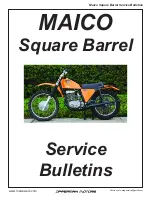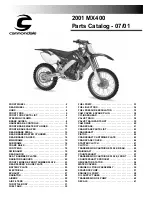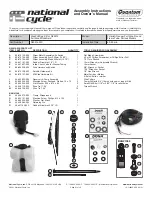
83
ENG
LISH
PREPARING THE FUEL
(for models Regolar-
ità Competizione and SuperSei Competizione)
The above models do not have the mixing unit
for the fuel or the relative reservoir.
In this case the user must manually put oil
into the fuel tank at the moment of refuel-
ling, using a special graduated measure.
The quantity of oil to be poured into the tank
is in proportion to the litres of petrol that are
put in.
A ratio of 2% is recommended for this en-
gine.
For the type of oil to be used, see page 100 (LU-
BRICANTS).
Replace the cap and shake the vehicle so that
the oil and petrol are mixed inside the tank.
Take great care to comply with the percent-
age of oil. If an incorrect amount is added,
there is the risk of affecting vehicle function-
ality.
BRAKES
BRAKE FLUID
The brake fluid is:
- harmful by inhalation, if swallowed or in
contact with skin, with possible serious con-
sequences;;
- irritating to skin;
- harmful to the soil and aquatic environment,
harmful to flora and fauna.
To be avoided:
- contact with skin;
- inhalation of vapours;
- ingestion;
- release to the environment;
- exposure to air.
If swallowed do
NOT
induce vomiting but seek
medical advice immediately (first aid post),
indicating the cause and how the accident oc-
curred.
After contact with skin, wash the affected part
immediately with soap and water, repeating the
operation until completely clean.
In case of contact with eyes or ears, rinse the
affected parts immediately with plenty of water
and seek medical advice immediately (first aid
post), indicating the cause and how the accident
occurred.
After contact with clothes, remove contaminated
articles and wash immediately with plenty of
water and soap. Change the dirty clothes, which
must be washed as soon as possible.
If brake fluid is accidentally spilt, clean the af-
fected area thoroughly.
Always wear latex gloves to protect hands when
carrying out maintenance.
Always close the brake fluid cover well after
every filling up.
KEEP OUT OF REACH OF CHILDREN. DISPOSE
OF THE BRAKE FLUID AT A SPECIAL WASTE
COLLECTION POINT.
The used brake fluid must be put in a sealed
container and taken to the nearest service sta-
tion or to a waste oil collection point where it
will be disposed of correctly.
DISK BRAKES
The brakes are a fundamental part for vehicle
safety. Always keep them fully efficient. Check
them for wear prior to setting off on any jour-
ney.
A decrease in braking power could be caused by
water depositing on the disks and on the brake
pads and it is therefore recommended that the
vehicle be dried thoroughly after washing. If trav-
elling on wet roads, proceed with caution and
continuously try out the brakes.
Also the salt used to melt snow and ice causes a
decrease in the efficiency of the braking system,
as does grease, oil and brake fluid; in this case it
is best to change the pads.
Whenever the pads are changed, take care for
the first 200 km when braking, as the pads do
not immediately adhere perfectly to the disk.
During this period it is preferable to brake early
and to apply the brake lever more forcefully,
while avoiding abrupt and prolonged braking so
as not to burn the pads and disks.
Do not use the vehicle if brake fluid is detected
leaking from the braking system.
The vehicle is fitted with disk brakes both at the
front and the rear, with separate hydraulic cir-
cuits.
Summary of Contents for Caballero 50
Page 1: ......
Page 45: ...45 ITALIANO NOTE ...
Page 49: ...49 ITALIANO ...
Page 52: ...52 ...
Page 100: ...100 NOTES ...
Page 103: ...103 ENGLISH ...
Page 106: ...106 ...
Page 154: ...154 NOTES ...
Page 160: ...160 ...
Page 168: ......
















































